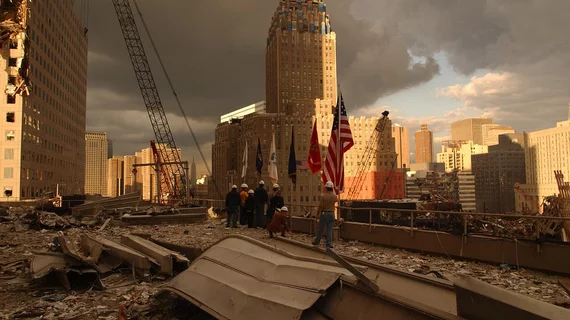New York City firefighters exposed to dust and debris from the World Trade Center (WTC) attacks on and after Sept. 11, 2001, are far more likely to experience an adverse cardiovascular event in the long-term, according to a study published in JAMA Network Open Sept. 6.
First author Hillel W. Cohen, DrPH, MPH, and colleagues said in the journal that while researchers have been collecting data on 9/11 survivors and first responders for a decade and a half now—the WTC Health Registry began enrolling participants in 2003 and is now the largest registry in U.S. history to track the health effects of a disaster—little information exists regarding the long-term CV outcomes of those affected by the terrorist attacks.
We know blue-collar workers who helped clean up debris after the WTC attacks experience post-traumatic stress disorder at double the rate of the general population, simultaneously elevating their risk of MI and stroke down the line. Kids who lived in neighborhoods near Ground Zero at the time of the tragedy have shown early signs of cardiovascular risk, and in 2018, 15 men who were on or near the WTC site the day of the attacks reported they’d been diagnosed with breast cancer.
Cohen and co-authors focused on Fire Department of New York (FDNY) firefighters for their study, which tracked the health of 9,796 men between Sept. 11, 2001, and Dec. 31, 2017. The team estimated CVD risk in association with two measures of WTC exposure—arrival time to the WTC site and duration of work at the site.
The researchers identified 489 primary outcome events during the study’s 16-year follow-up period, including cases of MI, stroke, unstable angina, coronary artery surgery, angioplasty and CVD death. At the study’s baseline, most men were around 40 years old and nearly three-quarters were never-smokers.
Hillel et al. reported FDNY firefighters were 44% more likely to experience the study’s primary outcome if they arrived at the scene earlier versus later. Similarly, men who worked at the WTC site for six or more months were 30% more likely to experience a CVD event than those who worked onsite for shorter periods.
“This finding suggests that discrete exposure to dust and products of combustion could have initiated persistent pathologic processes related, in part, to chronic inflammation that increased CVD risk years later,” the authors wrote. “Increased risk for other health outcomes has also been noted in this cohort.”
Well-established CVD risk factors were linked to heart disease in a series of multivariable models, as well. Hypertension was tied to a 41% increased risk of CVD, hypercholesterolemia yielded a 56% increased risk of CVD and diabetes meant a 99% increased risk of CVD. If a worker was a smoker at the time of the attacks, their risk of heart disease was more than doubled; if they were a former smoker, their risk of CVD jumped 55%.
“[Our] findings appear to reinforce the importance of long-term monitoring of the health of survivors of disasters,” Cohen and colleagues wrote. “Future studies are warranted to address whether identifying and addressing changes in other CVD risk factors can mitigate elevated CVD risk associated with disaster exposure.”

